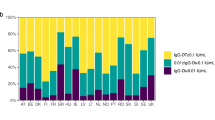Abstract
Public health initiatives to immunize children and adults have effectively reduced the number of tetanus cases in the USA. However, in the third National Health and Nutrition Examination Survey (NHANES III), immigrants from Mexico had a 67% non-protective anti-tetanus antibody (ATA) level. Less work has been conducted among other immigrant populations to determine the extent of this observation. Objective To measure ATA levels among the Korean-American immigrant population. Methods A convenience sample of 50 Korean Americans born outside the USA was recruited to determine the levels of ATA. A non-protective level of ATA was defined as below 0.15 IU/ml. Results The mean age was 59.5 years and 82% were female. There were 43/50 (86% (95% confidence limits 76, 96)) patients with a non-protective ATA level. Those between the ages of 50–59 years (94% were seronegative) and 60 years-highest age (92% were seronegative) were among the least likely to be protected. Neither gender nor a self-reported history of past tetanus immunization or military service predicted protection to tetanus. Discussion In this pilot study we found that 86% of Korean immigrants did not have protective ATA levels, with patients in the 50–59 year age range as unlikely to be protected as the older subjects. Patient reported history was unreliable in determining whether an individual had protective levels. Conclusion The vast majority of sampled Korean American immigrants lack protective ATA levels and are in need of immunization. Additional study is needed to determine the risk of other immigrant groups to tetanus.
Similar content being viewed by others
References
Gergen PJ, McQuillan GM, Kiely M, et al. A population-based serologic survey of immunity to tetanus in the United States. N England J Med 1995;332:761–6.
http://www.cdc.gov/vaccines/pubs/pinkbook/downloads/tetanus.pdf. Accessed 24 Dec 2007.
Centers for Disease Control and Prevention. Notice to readers food and drug administration approval of an acellular pertussis vaccine for the initial four doses of the diphtheria, tetanus, and pertussis vaccination series. MMWR Morb Mortal Wkly Rep 1996;45(31):676–7.
Centers for Disease Control and Prevention. Notice to Readers: update on the supply of tetanus and diphtheria toxoids and of diphtheria and tetanus toxoids and acellular pertussis vaccine. MMWR Morb Mortal Wkly Rep 2001;50(10):189–90.
Centers for Disease Control and Prevention. Preventing tetanus, diphtheria, and pertussis among adults: use of tetanus toxoid, reduced diphtheria toxoid, and acellular pertussis vaccine. Recommendations of the advisory committee of immunization practices (ACIP) and recommendation of ACIP supported by health care infection control practices committee (HICPAC), for use of Tdap among healthcare personnel. Mortal Wkly Rep 2006;55(RR17):1–36.
Talan D, Moran G, Abrahamian FA, et al. Tetanus immunity and physician compliance with tetanus prohylaxis practices among emergency department patients presenting with wounds. Ann Emerg Med 2004;43(3):305–14.
Centers for Disease Control and Prevention. Tetanus surveillance—United States, 1998—2000. MMWR Morb Mortal Wkly Rep 2003;52(SS03):1–8.
McQuillian GM, Kruszon-Moran D, Deforest A, et al. Serologic immunity to diphtheria and tetanus in the United States. Ann Intern Med 2002;136:660–6.
National Center for Health Statistics. Plan and operation of the third national health and nutrition examination survey, 1988–94. Vital Health Stat 1 1994;1(32):1–407.
Kang J, Hur JK, Lee SH, et al. Age related serosurvey of immunity to tetanus in korean populations. Korea J Infect Dis 2001;33:104–11.
Shin DH, Yu HS, Kim SJ, et al. Recently occurring adult tetanus in Korea: emphasis on immunization ad awareness of tetanus. J Korean Med Sci 2003;18:11–6.
Alagappan K, Rennie W, Kwiatkowski T, et al. Seroprevalence of tetanus antibodies among adults older than 65 years. Ann Emerg Med 1996;28:18–21.
Balestra DJ, Littenberg B. Shoud adult tetanus immunization be given as a single vaccination at age 65? A cost-effective analysis. J Gen Intern Med 1993;8:405–12.
Alagappan K, Rennie W, Auerbach C. Immunologic response to tetanus toxoid in the elderly: one-year follow-up. Ann Emerg Med 1998;32:155–60.
Centers for Disease Control and Prevention. Notice to readers assessing adult vaccination status at age 50 years. MMWR Morb Mortal Wkly Rep 1995;44(29):561–3.
Acknowledgements
Support provided by The Feinstein Institute for Medical Research NSLIJHS General Clinical Research Center, Grant #M01 RR018535 from the National Center for Research Resources (NCRR), a component of the National Institutes of Health (NIH). Its contents are solely the responsibility of the authors and do not necessarily represent the official view of NCRR or NIH.
Author information
Authors and Affiliations
Corresponding author
Rights and permissions
About this article
Cite this article
Alagappan, K., Park, R., Naderi, S. et al. Evaluation for Tetanus Antibodies in Korean-Americans Living in the New York Area: A Pilot Study. J Immigrant Minority Health 11, 105–107 (2009). https://doi.org/10.1007/s10903-008-9123-9
Received:
Accepted:
Published:
Issue Date:
DOI: https://doi.org/10.1007/s10903-008-9123-9




